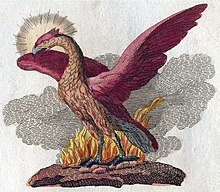Phoenix (mythology)

In Greek mythology, a phoenix or phenix (Greek: φοῖνιξ phoinix) is a long-lived bird that is cyclically regenerated or reborn. Associated with the sun, a phoenix obtains new life by arising from the ashes of its predecessor. The phoenix was subsequently adopted as a symbol in Early Christianity. While the phoenix typically dies by fire in most versions of the legend, there are less popular versions of the myth in which the mythical bird dies and simply decomposes before being born again.[1] According to some legends, the phoenix could live over 1400 years before rebirth.[2] Herodotus, Lucan, Pliny the Elder, Pope Clement I, Lactantius, Ovid, and Isidore of Seville are among those who have contributed to the retelling and transmission of the phoenix motif.
In the historical record, the phoenix "could symbolize renewal in general as well as the sun, time, the empire, metempsychosis, consecration, resurrection, life in the heavenly Paradise, Christ, Mary, virginity, the exceptional man, and certain aspects of Christian life".[3]
Etymology
The modern English noun phoenix derives from Middle English phenix (before 1150), itself from Old English fēnix (around 750). Old English fēnix was borrowed from Medieval Latin phenix and, later, from Latin phoenīx, deriving from Greek φοῖνιξ phoinīx.[4]
During the Classic period, the name of the bird, φοῖνιξ, was variously associated with the color purple,[5] 'Phoenician', and the date palm.[6] According to an etymology offered by the 6th- and 7th-century archbishop Isidore of Seville, the name of the phoenix derived from its purple-red hue, an explanation that has been influential into the medieval period, albeit in a different fashion; the bird was considered "the royal bird".[6]
With the deciphering of the Linear B script in the 20th century, however, the ancestor of Greek φοῖνιξ was confirmed in Mycenaean Greek po-ni-ke, itself open to a variety of interpretations.[7]
Relation to the Egyptian benu
Classical discourse on the subject of the phoenix points to a potential origin of the phoenix in Ancient Egypt. In the 19th century scholastic suspicions appeared to be confirmed by the discovery that Egyptians in Heliopolis had venerated the benu, a solar bird observed in some respects to be similar to the Greek phoenix. However, the Egyptian sources regarding the benu are often problematic and open to a variety of interpretations. Some of these sources may have been influenced by Greek notions of the phoenix.[8]
Appearance
In terms of physical appearance, the phoenix, when pictured or described in antique and medieval artwork and literature, will sometimes have a nimbus (a physical feature that emphasizes the phoenix’s connection with the sun).[9] Quite often, the oldest images of phoenixes on record would have nimbuses with seven rays, just like Helios (the personified sun in Greek mythology).[10] Pliny also describes the bird as having a crest of feathers on its head[9] and Ezekiel the Dramatist compared it to a rooster.[11] The phoenix is also commonly associated with royalty and the color purple.[12]
The phoenix was, generally, believed to be colorful and vibrant; Tacitus claimed that this was one aspect of the bird that made it stand out from all other birds.[13] Some thought it had peacock-like coloring, although there was no clear consensus about the mythical bird's coloring in antiquity (although Herodotus' claim of a red and yellow theme is popular in many versions of the story on record).[14] Ezekiel the Dramatist claimed that the phoenix had red legs and striking yellow eyes,[11] but Lactantius claimed that its eyes were blue like sapphires[15] and that its legs were covered in scales of yellow-gold with rose-colored talons.[16]
In terms of size, R. Van den Broek, Herodotus, Pliny, Solinus, and Philostratus describe the phoenix as similar in size to an eagle,[17] while Lactantius and Ezekiel the Dramatist both claim that the phoenix was larger; Lactantius wrote that the phoenix was larger than the ostrich.[18]
Analogues
Scholars have observed analogues to the phoenix in a variety of cultures. These analogues include the Arabic anqa (named after its prominent white neck), the Hindu garuda and gandaberunda, the Russian firebird, the Persian Simorgh, the Turkish Zümrüdü Anka, the Tibetan Me byi karmo, the Chinese fenghuang, and the Japanese hō-ō.[19]
See also
- Phoenix in popular culture. The Arabic word is Anqa. The Persian word is Simorgh
- Chol (bible), a Hebrew word sometimes glossed as phoenix, according to the English tanach.[20]
Notes
- ^ Van der Broek 1972, p. 146.
- ^ Lundy 1876, p. 425.
- ^ Van der Broek 1972, p. 9.
- ^ Barnhart 1995, p. 564.
- ^ R. S. P. Beekes, Etymological Dictionary of Greek, Brill, 2009, p. 1584.
- ^ a b Van der Broek 1972, p. 51.
- ^ Van der Broek 1972, pp. 62–66.
- ^ Van der Broek 1972, pp. 14–25.
- ^ a b Van der Broek 1972, pp. 233.
- ^ Van der Broek 1972, pp. 246–247.
- ^ a b Van der Broek 1972, pp. 257.
- ^ Van der Broek 1972, pp. 254.
- ^ Van der Broek 1972, pp. 253.
- ^ Van der Broek 1972, pp. 259.
- ^ Van der Broek 1972, pp. 256.
- ^ Van der Broek 1972, pp. 257–258.
- ^ Van der Broek 1972, pp. 251.
- ^ Van der Broek 1972, pp. 252.
- ^ Garry & El-Shamy 2005, pp. 84–87.
- ^ "And I said, I will perish with my nest, and I will multiply days as the phoenix (chol)." Iyov - Chapter 29 - Vers 18 Job 29:18
References
- Barnhart, Robert K (1995), The Barnhart Concise Dictionary of Etymology, HarperCollins, ISBN 0-06-270084-7.
- Garry, Jane; El-Shamy, Hasan (2005), Archetypes and Motifs in Folklore and Literature, ME Sharpe, ISBN 978-0-76561260-1.
- Van der Broek, R (1972), The Myth of the Phoenix, Seeger, I trans, EJ Brill.
- Lundy, John P. (1876), Monumental Christianity, JW Bouton

